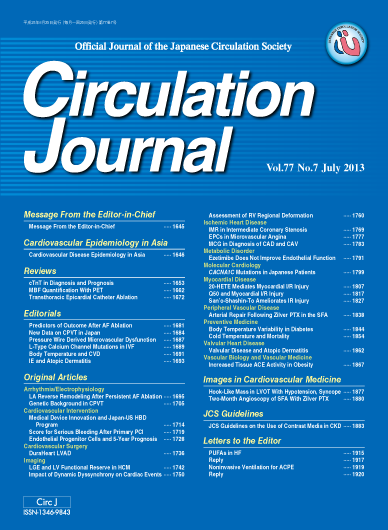77 巻, 7 号
選択された号の論文の42件中1~42を表示しています
- |<
- <
- 1
- >
- >|
Message From the Editor-in-Chief
-
2013 年 77 巻 7 号 p. 1645-
発行日: 2013年
公開日: 2013/06/25
[早期公開] 公開日: 2013/06/12PDF形式でダウンロード (224K)
Cardiovascular Epidemiology in Asia
-
2013 年 77 巻 7 号 p. 1646-1652
発行日: 2013年
公開日: 2013/06/25
[早期公開] 公開日: 2013/06/21PDF形式でダウンロード (2507K)
Reviews
-
2013 年 77 巻 7 号 p. 1653-1661
発行日: 2013年
公開日: 2013/06/25
[早期公開] 公開日: 2013/06/15PDF形式でダウンロード (1037K) -
2013 年 77 巻 7 号 p. 1662-1671
発行日: 2013年
公開日: 2013/06/25
[早期公開] 公開日: 2013/05/23PDF形式でダウンロード (936K) -
2013 年 77 巻 7 号 p. 1672-1680
発行日: 2013年
公開日: 2013/06/25
[早期公開] 公開日: 2013/06/12PDF形式でダウンロード (1238K)
Editorials
-
2013 年 77 巻 7 号 p. 1681-1683
発行日: 2013年
公開日: 2013/06/25
[早期公開] 公開日: 2013/05/30PDF形式でダウンロード (334K) -
2013 年 77 巻 7 号 p. 1684-1686
発行日: 2013年
公開日: 2013/06/25
[早期公開] 公開日: 2013/05/25PDF形式でダウンロード (409K) -
2013 年 77 巻 7 号 p. 1687-1688
発行日: 2013年
公開日: 2013/06/25
[早期公開] 公開日: 2013/05/16PDF形式でダウンロード (318K) -
2013 年 77 巻 7 号 p. 1689-1690
発行日: 2013年
公開日: 2013/06/25
[早期公開] 公開日: 2013/06/05PDF形式でダウンロード (244K) -
2013 年 77 巻 7 号 p. 1691-1692
発行日: 2013年
公開日: 2013/06/25
[早期公開] 公開日: 2013/05/25PDF形式でダウンロード (303K) -
2013 年 77 巻 7 号 p. 1693-1694
発行日: 2013年
公開日: 2013/06/25
[早期公開] 公開日: 2013/05/30PDF形式でダウンロード (692K)
Original Articles
Arrhythmia/Electrophysiology
-
2013 年 77 巻 7 号 p. 1695-1704
発行日: 2013年
公開日: 2013/06/25
[早期公開] 公開日: 2013/03/26PDF形式でダウンロード (2114K) -
2013 年 77 巻 7 号 p. 1705-1713
発行日: 2013年
公開日: 2013/06/25
[早期公開] 公開日: 2013/04/18PDF形式でダウンロード (1085K)
Cardiovascular Intervention
-
2013 年 77 巻 7 号 p. 1714-1718
発行日: 2013年
公開日: 2013/06/25
[早期公開] 公開日: 2013/03/29PDF形式でダウンロード (348K) -
2013 年 77 巻 7 号 p. 1719-1727
発行日: 2013年
公開日: 2013/06/25
[早期公開] 公開日: 2013/04/20PDF形式でダウンロード (973K) -
2013 年 77 巻 7 号 p. 1728-1735
発行日: 2013年
公開日: 2013/06/25
[早期公開] 公開日: 2013/04/11PDF形式でダウンロード (1015K)
Cardiovascular Surgery
-
2013 年 77 巻 7 号 p. 1736-1741
発行日: 2013年
公開日: 2013/06/25
[早期公開] 公開日: 2013/04/18PDF形式でダウンロード (329K)
Imaging
-
2013 年 77 巻 7 号 p. 1742-1749
発行日: 2013年
公開日: 2013/06/25
[早期公開] 公開日: 2013/04/02PDF形式でダウンロード (567K) -
2013 年 77 巻 7 号 p. 1750-1759
発行日: 2013年
公開日: 2013/06/25
[早期公開] 公開日: 2013/04/04PDF形式でダウンロード (2529K) -
2013 年 77 巻 7 号 p. 1760-1768
発行日: 2013年
公開日: 2013/06/25
[早期公開] 公開日: 2013/04/04PDF形式でダウンロード (1770K)
Ischemic Heart Disease
-
2013 年 77 巻 7 号 p. 1769-1776
発行日: 2013年
公開日: 2013/06/25
[早期公開] 公開日: 2013/03/27PDF形式でダウンロード (756K) -
2013 年 77 巻 7 号 p. 1777-1782
発行日: 2013年
公開日: 2013/06/25
[早期公開] 公開日: 2013/04/05PDF形式でダウンロード (386K) -
2013 年 77 巻 7 号 p. 1783-1790
発行日: 2013年
公開日: 2013/06/25
[早期公開] 公開日: 2013/04/19PDF形式でダウンロード (2540K)
Metabolic Disorder
-
2013 年 77 巻 7 号 p. 1791-1798
発行日: 2013年
公開日: 2013/06/25
[早期公開] 公開日: 2013/04/19PDF形式でダウンロード (1261K)
Molecular Cardiology
-
2013 年 77 巻 7 号 p. 1799-1806
発行日: 2013年
公開日: 2013/06/25
[早期公開] 公開日: 2013/04/11PDF形式でダウンロード (3112K)
Myocardial Disease
-
2013 年 77 巻 7 号 p. 1807-1816
発行日: 2013年
公開日: 2013/06/25
[早期公開] 公開日: 2013/04/13PDF形式でダウンロード (3959K) -
2013 年 77 巻 7 号 p. 1817-1826
発行日: 2013年
公開日: 2013/06/25
[早期公開] 公開日: 2013/04/11PDF形式でダウンロード (2286K) -
2013 年 77 巻 7 号 p. 1827-1837
発行日: 2013年
公開日: 2013/06/25
[早期公開] 公開日: 2013/04/24PDF形式でダウンロード (2884K)
Peripheral Vascular Disease
-
2013 年 77 巻 7 号 p. 1838-1843
発行日: 2013年
公開日: 2013/06/25
[早期公開] 公開日: 2013/04/17PDF形式でダウンロード (1609K)
Preventive Medicine
-
2013 年 77 巻 7 号 p. 1844-1853
発行日: 2013年
公開日: 2013/06/25
[早期公開] 公開日: 2013/03/27PDF形式でダウンロード (1447K) -
2013 年 77 巻 7 号 p. 1854-1861
発行日: 2013年
公開日: 2013/06/25
[早期公開] 公開日: 2013/04/17PDF形式でダウンロード (875K)
Valvular Heart Disease
-
2013 年 77 巻 7 号 p. 1862-1866
発行日: 2013年
公開日: 2013/06/25
[早期公開] 公開日: 2013/03/27PDF形式でダウンロード (546K)
Vascular Biology and Vascular Medicine
-
2013 年 77 巻 7 号 p. 1867-1876
発行日: 2013年
公開日: 2013/06/25
[早期公開] 公開日: 2013/04/20PDF形式でダウンロード (2695K)
Images in Cardiovascular Medicine
-
2013 年 77 巻 7 号 p. 1877-1879
発行日: 2013年
公開日: 2013/06/25
[早期公開] 公開日: 2013/03/27PDF形式でダウンロード (474K) -
2013 年 77 巻 7 号 p. 1880-1882
発行日: 2013年
公開日: 2013/06/25
[早期公開] 公開日: 2013/03/29PDF形式でダウンロード (424K)
JCS Guidelines
-
2013 年 77 巻 7 号 p. 1883-1914
発行日: 2013年
公開日: 2013/06/25
[早期公開] 公開日: 2013/06/15PDF形式でダウンロード (1294K)
Letters to the Editor
-
2013 年 77 巻 7 号 p. 1915-1916
発行日: 2013年
公開日: 2013/06/25
[早期公開] 公開日: 2013/04/26PDF形式でダウンロード (219K) -
2013 年 77 巻 7 号 p. 1917-1918
発行日: 2013年
公開日: 2013/06/25
[早期公開] 公開日: 2013/04/26PDF形式でダウンロード (660K) -
2013 年 77 巻 7 号 p. 1919-
発行日: 2013年
公開日: 2013/06/25
[早期公開] 公開日: 2013/04/25PDF形式でダウンロード (204K) -
2013 年 77 巻 7 号 p. 1920-
発行日: 2013年
公開日: 2013/06/25
[早期公開] 公開日: 2013/04/25PDF形式でダウンロード (205K)
-
2013 年 77 巻 7 号 p. Cover7-
発行日: 2013年
公開日: 2013/06/25
PDF形式でダウンロード (366K) -
2013 年 77 巻 7 号 p. Content7-
発行日: 2013年
公開日: 2013/06/25
PDF形式でダウンロード (235K)
- |<
- <
- 1
- >
- >|
